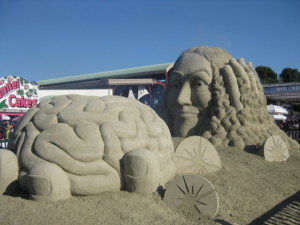I was preparing my latest favorite work-suitable drink a few minutes ago, and a drop of tea spilled over the side of the mug and ran down to the base. Naturally it immediately spread around the entire base, forming a ring on the desk. It was easily wiped up, but then I thought—why does it always spread around the entire base to form that unmistakable coffee ring?
It occurred to me that it might just be capillary action with the liquid flowing along the V-shaped channel formed by the table and the edge of the mug. Some googling did turn up the fact that ring-shaped coffee stains from single drops are caused by capillary flow [dead link]: as the drop evaporates, it draws water from the inside.
But the instant ring from the mug? Either it’s something else, or it’s so obvious no one has thought it worth writing about.



Yup, that’s definitely capillary action, or at least it’s caused by the same physical reasons.
Essentially, what’s happening is that the water is in a lower-energy state when it’s against certain kinds of solid surfaces (such as glass and ceramic) than when it’s in the middle of the drop. So, if you stick a glass tube in some water, there’s this balance between the water wanting to creep up the glass so more of it is against the surface, and gravity wanting to pull it back down, and it ends up in a position where those two things balance out.
In the coffee-ring situation, gravity doesn’t balance it, so it just keeps going until it’s covered as much solid surface area as it can. (What eventually balances it there is the fact that water-air surface has higher energy, and so it doesn’t do things that increase that very much. That’s why it only wets the area where the coffee cup is nearly touching the table.)
There’s a related common experiment, where you put a drop of water on a clean glass surface, and a drop on a waxed surface. The water-glass surface is a low-energy state, and so the drop spreads out to get a lot of it. The water-wax surface is a high-energy state, and so the drop beads up to touch very little of it.
Thanks for the explanation!
Thanks for the in depth comments, I’ve often wondered, but never found an answer until now.
Thanks again.